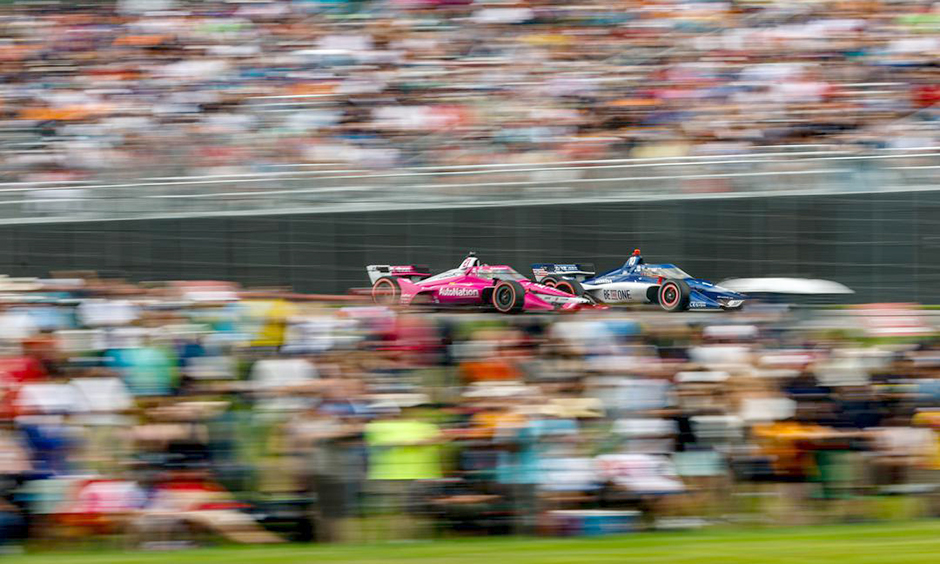
By Eric Smith- Indycar.com
This week’s Honda Indy 200 at Mid-Ohio Presented by the 2025 Civic Hybrid sparks a new era of the NTT INDYCAR SERIES with the anticipated debut of the hybrid system. The competitors are eager to see the impact.
“Overall, it’s a great change for the series,” AJ Foyt Racing driver Santino Ferrucci said.
So, what is this new technology?
The existing 2.2-liter, twin-turbocharged V-6 engine remains. What’s new is an innovative hybrid system comprised of a low voltage (48V) Motor Generator Unit (MGU) and Energy Storage System (ESS) – consisting of 20 ultracapacitors – both of which fit inside the bellhousing located between the Chevrolet and Honda INDYCAR SERIES internal combustion engine and the gearbox.
The NTT INDYCAR SERIES joins other global motorsports series like Formula E, which is all electric, IMSA’s WeatherTech Sports Car Championship and the FIA World Endurance Championship using hybrid power.
“If you look at where the world is going, where manufacturers are going, you have to evolve,” Arrow McLaren driver Alexander Rossi said. “It’s an exciting time for the series to take that step toward the future. It’s something that’s important to all of us and the partners involved.”
“It is exciting to have a little bit of a change with the hybrid technology,” said Colton Herta of Andretti Global w/Curb Agajanian. “I know a lot of people are excited about it from the engine manufacturer’s side because it’s a new challenge for everybody.”
The hybrid unit is a first-of-its-kind collaboration between the engine manufacturers in the NTT INDYCAR SERIES. During regeneration, acting on the clutch shaft, the Motor Generator Unit (MGU) developed by Chevrolet/Ilmor builds power to be stored in the Energy Storage System (ESS) developed by Honda. The additional horsepower is deployed through the same motor generator on drivers’ demand.
The engine was initially paired and tested with hybrid power in August 2023 at Sebring International Raceway. In just 10 months, 25,921 miles have been successfully completed among 30 NTT INDYCAR SERIES drivers.
Additional testing sessions included ovals at Indianapolis Motor Speedway, the Milwaukee Mile and World Wide Technology Raceway and road courses at Barber Motorsports Park, Homestead-Miami Speedway, IMS and Road America.
Beginning this weekend, deployment of the hybrid assist is only available through a latching button similar to the existing Push to Pass system.
On road and street courses, the hybrid assist can be used with Push to Pass, which combined offers an additional 120-plus horsepower. That pushes the horsepower of the NTT INDYCAR SERIES machinery, which will be utilized at Mid-Ohio Sports Car Course in Lexington, Ohio this weekend to more than 800 for the first time in two decades.
Push to Pass will still have a restriction on the amount of time per use and total time used over the course of a race. Rules for the hybrid power unit will limit the amount of energy deployed per lap based on track length.
For competition, options for automatic regeneration via braking or throttle position and manual regeneration via selected steering wheel paddles and buttons will be available.
Safety elements include the low-voltage system and, on road and street circuits, the ability for drivers to restart the car themselves if they spin and stall the engine on the track. That reduces the need for the AMR INDYCAR Safety Team to be deployed resulting in more green-flag action.
The INDYCAR hybrid powerplant maintains the fast, loud and authentic sound of INDYCAR SERIES machinery and with the ability to harness otherwise wasted energy, the hybrid package is part of the greater sustainability program in the NTT INDYCAR SERIES in addition to Shell’s 100% Renewable Race Fuel, which made its debut in 2023, Renewable diesel used in the teams’ race car transporters and Firestone’s innovative and sustainable alternate race tire with green sidewalls made from guayule rubber have also been added to the series in recent years.
By Eric Smith – Indycar.com


